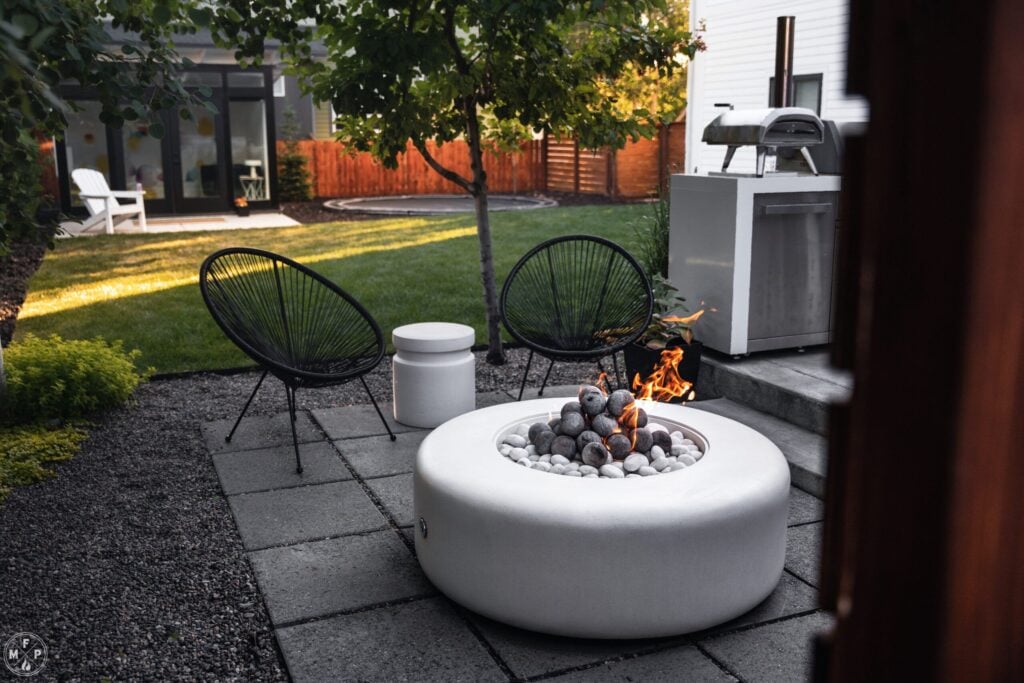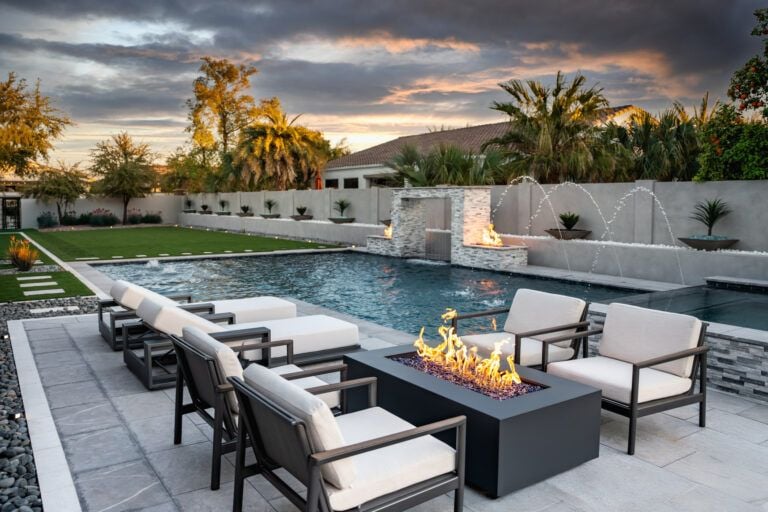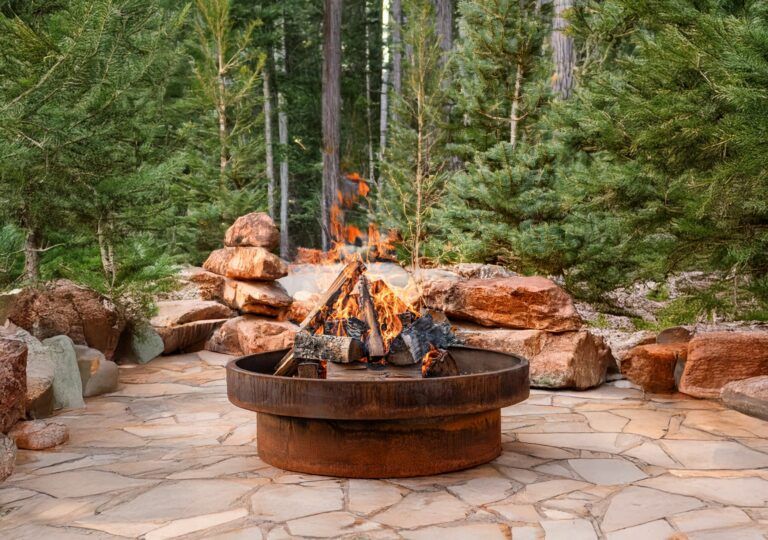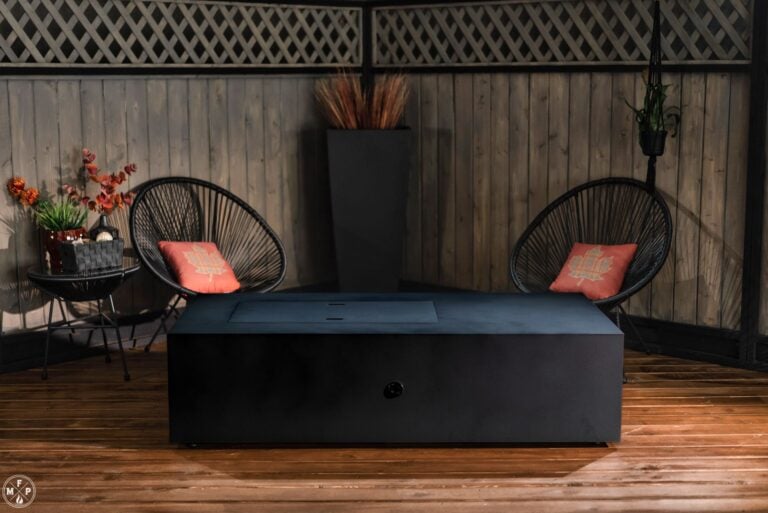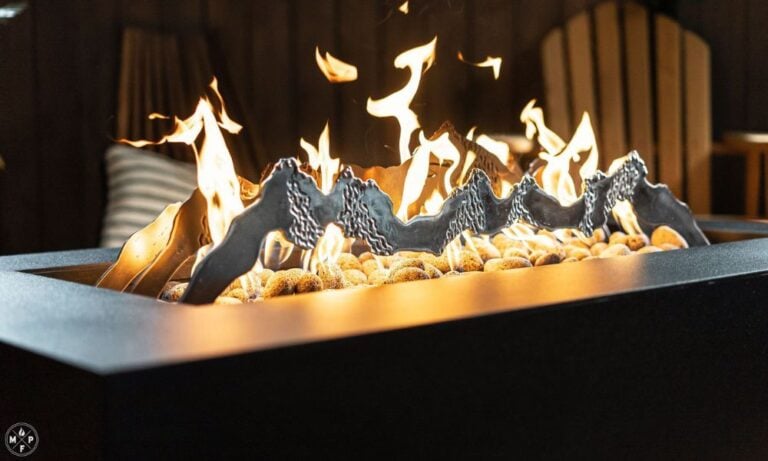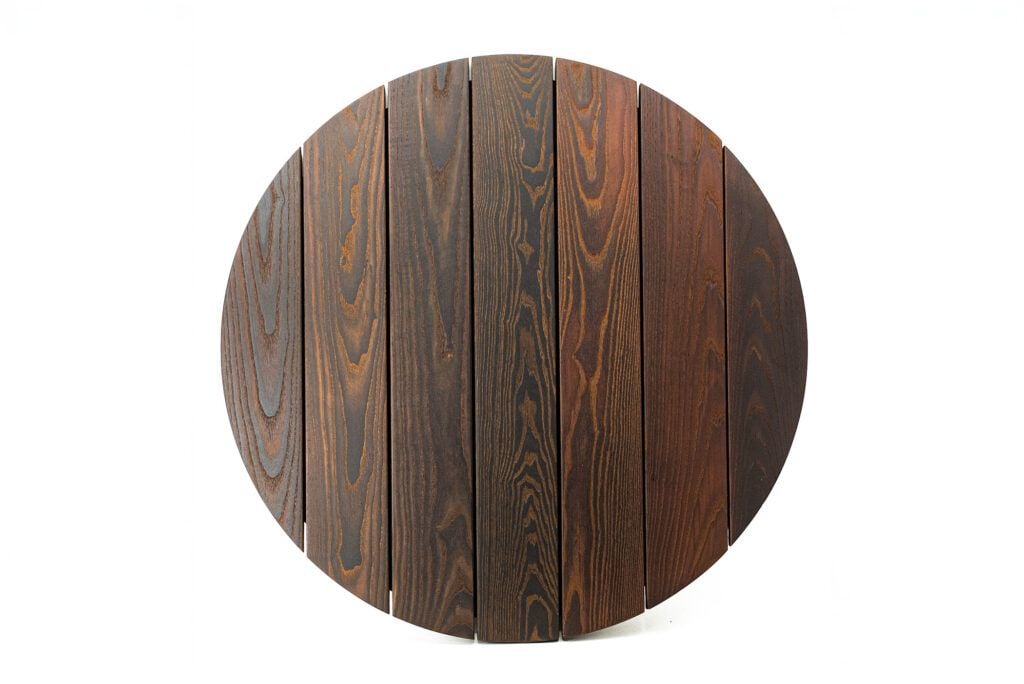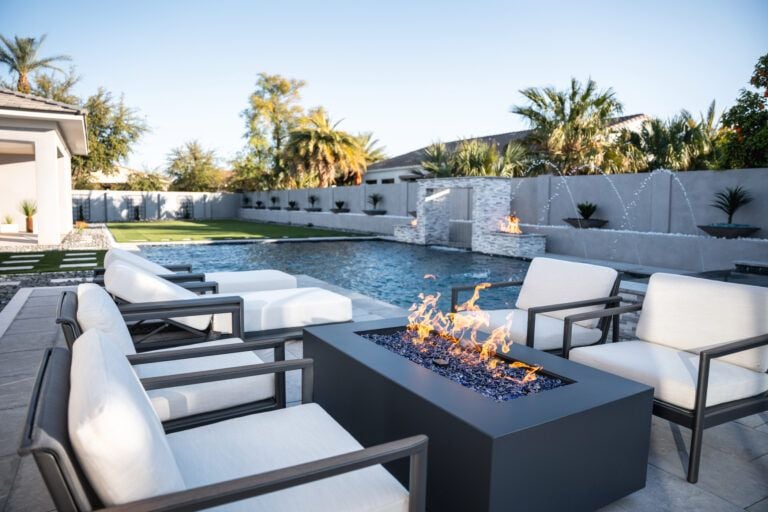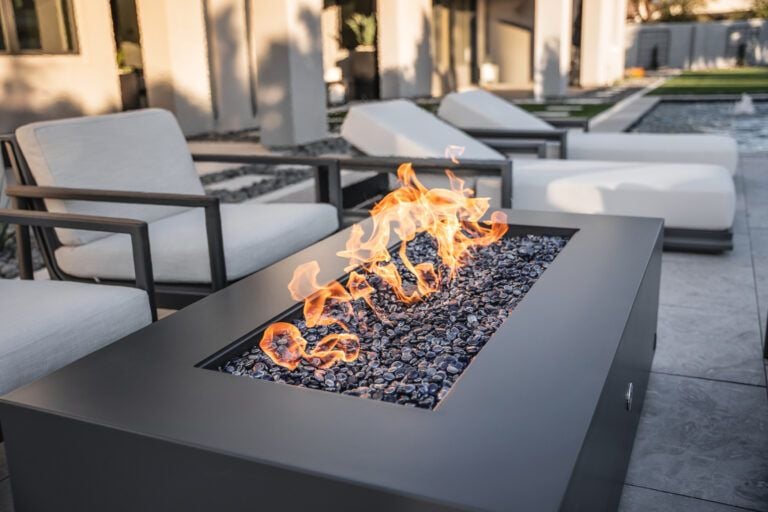
All about your Fuel choices: Propane vs. Natural Gas Fire Features
You’re picturing those relaxing evenings gathered around a warm fire, and you’re ready to make that dream a reality. But before you design that perfect fire pit or fire table, there’s an important choice to make: propane or natural gas?
Both fuel types power those captivating flames, but they each come with their own set of advantages and disadvantages. This guide will break down the pros and cons, helping you determine the perfect match for your lifestyle and fire feature dreams.
Propane: Freedom and Flexibility
Let’s explore the world of propane and discover if it’s the right fuel to ignite your outdoor fire feature.
Pros:
- Location, Location, Location: Propane’s portability opens up a world of possibilities. No need to be tethered to a natural gas line – tuck your fire feature into that secluded corner of your backyard or perch it on your patio with ease.
- Off-the-Grid Bliss: If natural gas isn’t available in your area, propane is your go-to solution for radiant heat.
- Tank Options: Choose from various tank sizes to suit your needs. From portable 20lb tanks for smaller fire features to larger tanks for extended burn times.
Cons:
- The Price of Freedom: Propane generally burns more expensively than natural gas. Get ready for potentially higher fuel costs and the occasional tank refill.
- Safety First: Propane is heavier than air, meaning it sinks. Proper ventilation is crucial to prevent unwanted accumulation.
- Tank Troubles: Hiding a propane tank can be an aesthetic challenge, and those refills can be a bit of a hassle.
- Soot Happens: Propane tends to produce more soot buildup on fire media like ceramic logs, requiring occasional cleaning.
Using a Propane Tank: Size and Safety
When it comes to propane tanks for your fire feature, you’ve got options! A standard 20-pound tank is a good choice for smaller burner systems. Those under 180,000 BTUs, and will typically give you 6 to 12 hours of burn time. If you have a larger burner or want longer burn times, a 30- or 40-pound tank is a better bet. And for those who really love their flames and have extra-large fire features, high-volume tanks are available through your local propane supplier.


Another tip is that no one wants an unsightly propane tank cluttering their patio. Consider using a propane tank cover to keep it concealed and maintain that beautiful outdoor aesthetic. At Montana Fire Pits you can choose from both Steel and Arbor Wood covers. They will also double as end tables or extra seating.
Natural Gas: Convenience and Cost-Effectiveness
Now, let’s turn our attention to natural gas and explore the convenience and cost-effectiveness it offers for fire features.
Pros:
- Wallet-Friendly Flames: Natural gas typically burns cheaper than propane, keeping your energy bills in check. Enjoy those flames without breaking the bank.
- Endless Burning: Say goodbye to “tank anxiety.” With a natural gas line, you have a constant fuel supply for uninterrupted fireside enjoyment.
- Rise Above: Natural gas is lighter than air, reducing the risk of fuel accumulation and enhancing safety.
- Cleaner Burn: Enjoy a slightly cleaner burn with less soot buildup on your fire media.
Cons:
- Location Limitations: Natural gas ties you to an existing gas line, limiting placement options for your fire feature.
- Installation Considerations: You might need a meter upgrade or larger gas lines to ensure adequate fuel supply, potentially adding to installation costs.
- Pressure Fluctuations: Shared gas lines can experience pressure variations depending on appliance usage in your home.
- Difficult Relocation: Once installed, moving your natural gas fire feature can be a complex and costly endeavor.
There are various pros/cons of Propane (LP) and Natural Gas (NG). The difference between LP and NG Warming Trends burners are the “jets”. If, down the road, you need to convert from LP to NG or vise-versa, you can do so by purchasing replacement jets from Montana Fire Pits at $26 each.
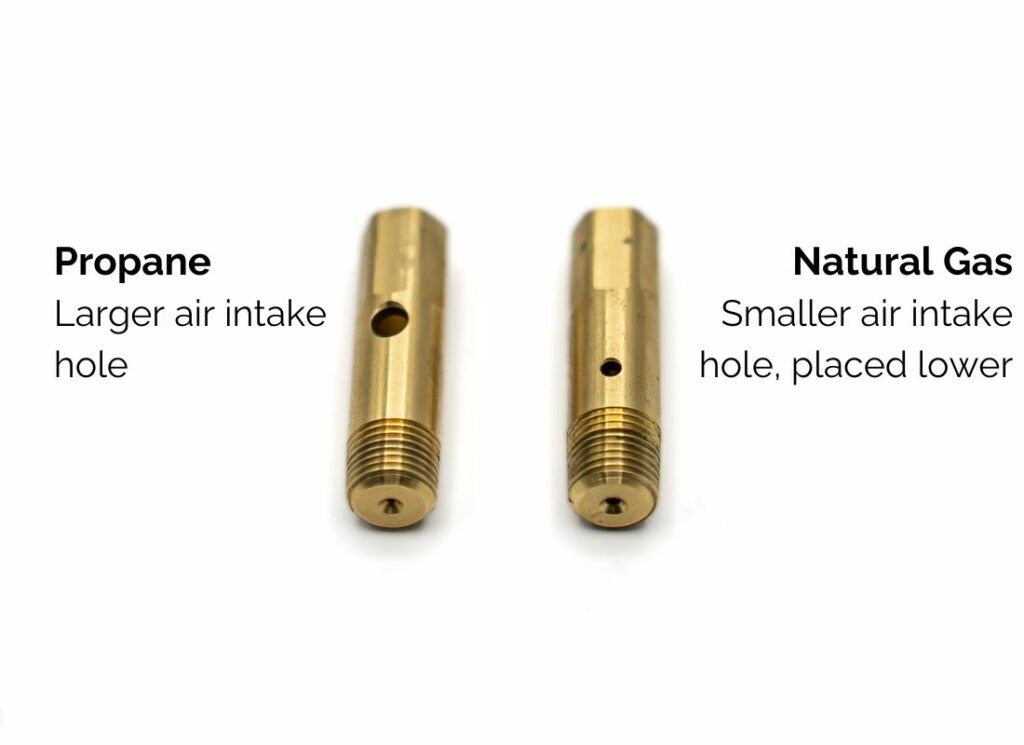
Gas Line Sizing: Ensuring Optimal Fuel Flow
Achieving those picture-perfect flames for your fire feature depends heavily on proper gas line sizing, regardless of whether you opt for propane or natural gas. Think of it like a highway system for your fuel. A larger diameter gas line ensures a smooth and efficient flow of fuel, delivering sufficient volume and pressure to your burner. That is especially the case over longer distances. To guarantee optimal performance, your gas line’s BTU capacity should be at least 60-70% of your burner’s BTU rating. Here is a good Propane Gas Line Sizing Chart as well as a Natural Gas Line Sizing Chart for you to use. While these guidelines provide a good starting point, consulting a qualified fuel professional is always recommended for the most accurate assessment and to ensure safe and efficient operation.

Pro Tip: If you’re still in the planning stages of your fire feature installation, consider running your gas line in conduit. This simple step can save you headaches down the road by making any future repairs or modifications much easier. It can also prevent the need to excavate your yard.
Gas Pressure: Finding the Sweet Spot
Getting the right flame height and heat output from your fire feature depends on having the correct gas pressure. Think of it like Goldilocks and the Three Bears – you don’t want the pressure too high or too low, but just right! For propane, aim for a pressure between 11 and 13 inches of water column. If you’re using natural gas, you’ll want the pressure to be between 7 and 10 inches of water column. To accurately measure this, you can use a handy tool called a manometer. If the pressure is too high, you might hear some unwanted noise coming from your fire feature. On the other hand, if the pressure is too low, the flames might be smaller and less impressive.
Gas Stub Location: Hidden and Convenient

The gas stub is the point where your fire feature connects to the gas line, and its placement plays a key role in both aesthetics and functionality. Ideally, you’ll want to position the gas stub underneath the fire feature, keeping it hidden from view for a clean and polished look. However, sometimes an off-center placement might be necessary. This is true especially if you’re using electronic ignition components or if your fire feature sits low to the ground.
If you can’t bring the gas up underneath, you might consider a steel Venture Series fire table or even a Ready to Finish Kit. These systems can have four adjustable feet installed underneath. The feet will raise the fire table to create a gap large enough for you to run your gas line underneath. Just remember to keep the gas stub within easy reach of the key valve, usually within about 36 inches. That will ensure a smooth and straightforward connection.
Regulators and Air Mixers: Fine-Tuning Your Flames

When it comes to setting up your burner, you can breathe easy knowing you won’t need a separate air mixer. Our burners are cleverly designed with built-in air mixing at each individual jet. However, you will need a regulator to control the flow of propane, as it comes out of the tank at a much higher pressure than our burners require. If your burner has a BTU rating over 250,000, it’s best to reach out to a local propane supplier for advice on the correct regulator.
For burners with a lower BTU rating, you can find a regulator kit available for purchase directly from us. In cases where you have a longer gas line, you might need two regulators. One high-pressure regulator at the tank and a second “fine-tuning” regulator near the burner to ensure the pressure is just right (between 11 and 13 inches of water column). If you’ve opted for natural gas, it’s always a good idea to consult a qualified plumber or HVAC technician to make sure you have the proper regulator and setup.
Gas Consumption: Efficiency Matters

When it comes to fire features, efficiency matters! Warming Trends burners are designed to give you the most impressive flames while using the least amount of fuel. In fact, their innovative Crossfire burners use half the fuel compared to conventional burners. So you will get a bigger, brighter flame for your money.
Before you install your new fire feature, remember to check local regulations and obtain any necessary permits. Safety and compliance are important! You’ll be glad to know that Warming Trends burners meet the highest industry standards (ANSI and CSA) for outdoor decorative gas appliances.
Choosing between propane and natural gas depends on your specific needs and what you value most. If budget is a top priority, natural gas typically offers lower operating costs. However, if you need more flexibility in where you place your fire feature, propane might be the better choice. Natural gas offers the convenience of a continuous fuel supply without refills, but you might need to put some extra effort into concealing a propane tank. By carefully considering these factors, you can confidently choose the fuel type that best suits your lifestyle and creates the perfect flames for your outdoor space.
The MFP Advantage
- Professional Grade Quality
- Nationwide Shipping
- Made in the U.S.A.
- Distinctive, Hand-Built Products
- Vast Size & Finish Options
- Highest Customer Satisfaction
- Custom Design Available
Explore our exceptional line of fire and outdoor products and take your space to new levels of Luxury...
More to explorer
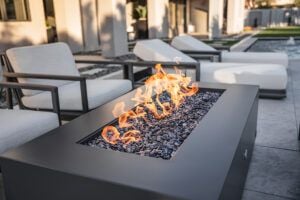
Top 10 Fire Pits of 2025: Warmth and Style for Your Outdoor Space
As the days get longer and the evenings get cooler, what better way to enjoy your outdoor space than with a fire
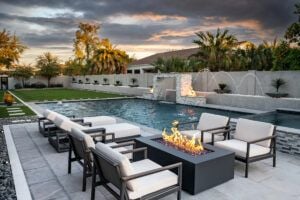
The Benefits of Multiple Fire Features in Backyard Design
Imagine stepping into your backyard and being greeted by the alluring dance of flames throughout your space! Creating a backyard design with
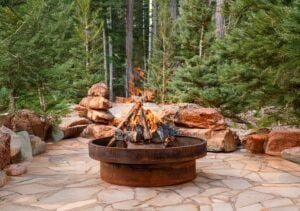
Discover the Timberline Collection of Wood Burning Fire Pits
In a world that’s constantly buzzing with the convenience of instant gratification, there’s a timeless appeal to the simple, primal pleasure of

